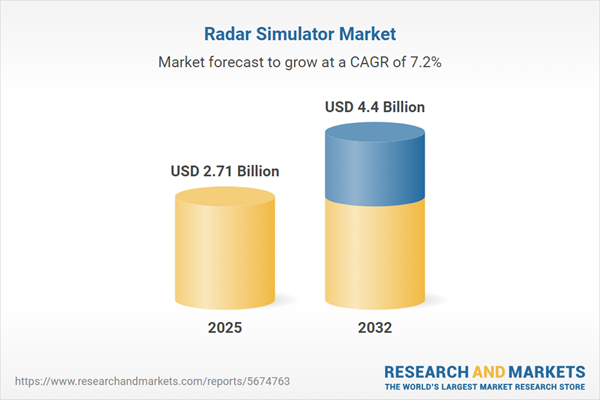Speak directly to the analyst to clarify any post sales queries you may have.
The radar simulator market continues to transform defense, automotive, maritime, and public safety sectors by delivering advanced, reliable simulation solutions that support mission-critical development, validation, and operational training in both military and civilian contexts. As digitalization and regulatory requirements accelerate, senior leaders face new opportunities and challenges in adopting these powerful platforms.
Market Snapshot of the Radar Simulator Market
The Radar Simulator Market grew from USD 2.53 billion in 2024 to USD 2.71 billion in 2025. It is expected to continue expanding at a CAGR of 7.15%, reaching USD 4.40 billion by 2032. This robust performance reflects sustained investments in defense modernization, increasing civilian adoption for automotive and public safety testing, and evolving technological innovation across regions.
Scope & Segmentation
This research delivers comprehensive analysis and forecasts across all major dimensions shaping the radar simulator sector:
- Application: Aerospace and defense training, weapon system testing, automotive applications including advanced driver assistance systems (ADAS), autonomous driving, collision avoidance, maritime simulation, and public safety training.
- Product Type: Analog radar simulators for legacy installations and digital radar simulators built for high-fidelity signal reproduction and dynamic waveform generation.
- Frequency Band: Solutions and modules for C-Band (including lower/upper), Ka-Band, S-Band, and X-Band supporting varied detection, range, and resolution scenarios.
- Deployment Mode: Fixed installations (field and laboratory), and portable units (bench and field portable) designed for remote site validation and on-the-go calibration.
- Operation Mode: Hardware in the loop (sensor and signal in the loop), software in the loop (algorithm and digital twin simulation), real time simulation, and post processing workflows.
- Regional Coverage: In-depth analysis spanning the Americas (North and Latin America), Europe, Middle East and Africa (including major regional markets), and Asia-Pacific (comprising key economies such as China, India, and Japan).
- Key Companies: Evaluation of industry leaders and specialized players including Thales S.A., Raytheon Technologies Corporation, Lockheed Martin Corporation, CAE Inc., L3Harris Technologies, BAE Systems, Leonardo S.p.A., Northrop Grumman Corporation, Saab AB, and Elbit Systems Ltd.
Key Takeaways for Industry Decision-Makers
- Adoption of radar simulation platforms is accelerating as organizations transition from analog to digitally-driven frameworks, optimizing training cycles and lowering operational risk.
- Artificial intelligence and machine learning integration are propelling simulation fidelity, enabling adaptive waveform control and predictive system analytics in highly variable electromagnetic environments.
- Modular solution architectures and open interface standards are critical for rapid customization, enhanced interoperability, and future resilience as regulatory demands and performance benchmarks evolve.
- Hybrid deployment models—blending hardware and software in the loop—address growing validation requirements for automotive autonomy, public safety network testing, and maritime operations.
- Regional market dynamics are shaped by joint force readiness initiatives in North America, regulatory harmonization in Europe, infrastructure investment across the Middle East and Africa, and digital transformation momentum within Asia-Pacific.
Tariff Impact
The imposition of tariffs by the United States has reshaped the global radar simulation value chain. Market participants are proactively diversifying suppliers, exploring domestic and nearshore manufacturing, and adapting procurement strategies. Increased regulatory scrutiny of cross-border research collaborations and export controls has encouraged industry consortia and accelerated the shift toward localized, resilient supply networks. End users increasingly seek modular systems that can withstand import cost fluctuations while service providers are transitioning to flexible, subscription-based pricing formats to address evolving budgetary needs in defense and civilian sectors.
Methodology & Data Sources
The report utilizes a multi-phase methodology, integrating direct expert consultations with leading figures in defense, automotive, maritime, and public safety domains. Extensive secondary research, including technical literature and vendor documentation, is combined with advanced analytical techniques to synthesize insights and validate trends across technology, supply chain, and end-user segments.
Why This Report Matters
- Enables strategic investment planning by offering in-depth segmentation across applications, technologies, and geographies—supporting precise opportunity assessment for radar simulator market growth.
- Supports supply chain resilience by detailing tariff impacts and guiding adaptation strategies in sourcing, production, and compliance frameworks.
- Assists innovation leaders in benchmarking key players and technology developments, aiding informed partnerships and go-to-market initiatives.
Conclusion
The radar simulator market is evolving into a key enabler for advanced training, technology validation, and operational readiness in both defense and civilian sectors. Success in this landscape demands adaptive platforms, resilient sourcing, and continuous innovation to meet shifting demands and maintain competitive advantage.
Additional Product Information:
- Purchase of this report includes 1 year online access with quarterly updates.
- This report can be updated on request. Please contact our Customer Experience team using the Ask a Question widget on our website.
Table of Contents
3. Executive Summary
4. Market Overview
7. Cumulative Impact of Artificial Intelligence 2025
Companies Mentioned
The companies profiled in this Radar Simulator market report include:- Thales S.A.
- Raytheon Technologies Corporation
- Lockheed Martin Corporation
- CAE Inc.
- L3Harris Technologies, Inc.
- BAE Systems plc
- Leonardo S.p.A.
- Northrop Grumman Corporation
- Saab AB
- Elbit Systems Ltd.
Table Information
| Report Attribute | Details |
|---|---|
| No. of Pages | 182 |
| Published | October 2025 |
| Forecast Period | 2025 - 2032 |
| Estimated Market Value ( USD | $ 2.71 Billion |
| Forecasted Market Value ( USD | $ 4.4 Billion |
| Compound Annual Growth Rate | 7.1% |
| Regions Covered | Global |
| No. of Companies Mentioned | 11 |









